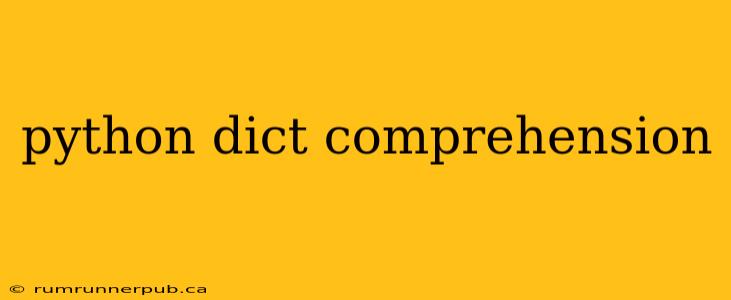Dictionary comprehensions in Python provide a succinct way to create dictionaries. They offer a more readable and efficient alternative to traditional for loops when constructing dictionaries from existing iterables. This article will explore dictionary comprehensions, drawing upon insights from Stack Overflow, and expanding upon them with practical examples and explanations.
The Basics: Syntax and Structure
The general syntax of a dictionary comprehension is as follows:
new_dict = {key_expression: value_expression for item in iterable if condition}
Let's break it down:
-
{key_expression: value_expression}: This defines how each key-value pair in the new dictionary will be formed.key_expressionandvalue_expressioncan be any valid Python expression. -
for item in iterable: This iterates over an existing iterable (like a list, tuple, or range). Eachitemis used to create a key-value pair. -
if condition(optional): This allows you to filter the items from the iterable; only items satisfying the condition will be included in the new dictionary.
Examples Inspired by Stack Overflow
Example 1: Squaring Numbers (inspired by various Stack Overflow questions regarding list comprehensions adapted for dictionaries)
Let's say we want to create a dictionary where the keys are numbers from 1 to 5 and the values are their squares. A traditional approach would be:
numbers = range(1, 6)
squared_numbers = {}
for number in numbers:
squared_numbers[number] = number**2
print(squared_numbers) # Output: {1: 1, 2: 4, 3: 9, 4: 16, 5: 25}
Using a dictionary comprehension, this becomes:
squared_numbers = {number: number**2 for number in range(1, 6)}
print(squared_numbers) # Output: {1: 1, 2: 4, 3: 9, 4: 16, 5: 25}
This is significantly more concise and arguably more readable.
Example 2: Filtering with a Condition (inspired by Stack Overflow questions on conditional dictionary creation)
Imagine we have a list of names and ages, and we only want to create a dictionary containing the names and ages of people over 30.
people = [("Alice", 25), ("Bob", 35), ("Charlie", 40), ("David", 28)]
older_people = {name: age for name, age in people if age > 30}
print(older_people) # Output: {'Bob': 35, 'Charlie': 40}
The if age > 30 clause elegantly filters the data, ensuring only relevant entries are added to the dictionary. This is far cleaner than a multi-line solution involving explicit conditional checks within a loop.
Advanced Techniques
Nested Dictionary Comprehensions: You can even nest dictionary comprehensions for more complex structures. For instance, creating a dictionary of dictionaries:
matrix = [[1, 2], [3, 4], [5, 6]]
dict_of_dicts = {i: {j: matrix[i][j] for j in range(len(matrix[i]))} for i in range(len(matrix))}
print(dict_of_dicts) #Output: {0: {0: 1, 1: 2}, 1: {0: 3, 1: 4}, 2: {0: 5, 1: 6}}
This creates a dictionary where keys are row indices and values are dictionaries representing each row with column indices as keys and cell values as values.
When to Use Dictionary Comprehensions
Dictionary comprehensions are ideal for:
- Creating dictionaries from existing iterables: When you have data already in a list, tuple, or other iterable and need to transform it into a dictionary.
- Improving code readability: They often result in more concise and understandable code compared to traditional
forloops. - Enhancing performance (slightly): Although the performance gain isn't always substantial, they can be slightly faster than equivalent
forloops for smaller datasets.
Note: For very large datasets, the performance difference between dictionary comprehensions and traditional loops might become negligible. The primary advantage in such cases remains readability and maintainability.
By mastering dictionary comprehensions, you can write more efficient and elegant Python code. This article, enriched by the spirit of Stack Overflow solutions and extended with additional examples and explanations, serves as a comprehensive guide to this powerful feature. Remember to always prioritize readable and maintainable code, regardless of the chosen technique.
